| | Distribution in Alberta | Noxious weed status | Eradication of purple loosestrife in Alberta | Environmental impacts of purple loosestrife | Alternative plants | Importance of volunteers | What can you do?
Purple loosestrife (Lythrum salicaria) is a herbaceous wetland perennial that was introduced into North America from Europe in the early 1800's. It is believed that Purple Loosestrife arrived in the ballasts of cargo ships. Other possibilities include deliberate introduction as an herb, rootstalks brought over by horticulturalists, and seed transport via imported raw wool and sheep. Purple Loosestrife has square, woody stalks growing to a height of 1-2 meters. It has smooth edged leaves which are 5-10 cm in length, attached directly to the stalk opposing one another (or occasionally, alternate). The plant forms 10-40 cm long pink/purple flowering spikes.
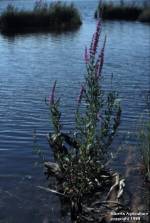
Purple loosestrife has a long purple flower stalk and can grow to 2 metres (6 feet) in height. | 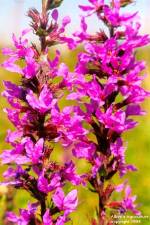
Purple loosestrife flowers have six bright purple, wrinkled petals. | 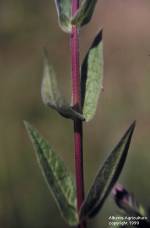
Purple loosestrife has a square woody stem and opposite leaves. |
Purple Loosestrife invades native wetland communities, forming a single-species stand that no bird, mammal or fish depends upon. Purple Loosestrife germinates and grows faster than any native wetland species. It soon forms dense brush-like stands usurping water and choking out native plants. Researchers monitoring the spread of loosestrife at a waterfowl impoundment in New York State found that in only 13 years purple loosestrife increased from five percent to 90 percent of the total biomass. Loosestrife reduces the size and diversity of natural plant communities. Once Purple Loosestrife invades an area and eliminates native flora, the wildlife that once depended upon the native flora are forced to move to new areas. Waterfowl will not eat loosestrife seeds. Muskrats eat around loosestrife stands. Wildlife species are displaced and those that cannot move into new areas are lost. What remains is a biological desert, devoid of native plant and wildlife species. In it's native range, Purple Loosestrife is not a problem. In Eurasia, there are more than 120 species of insects that prey on Purple Loosestrife, regulating population levels. The natural enemies of Purple Loosestrife were not transferred to North America with its introduction. Hence, the plant can grow and spread rapidly.
| |
If left unchecked purple loosestrife
will spread rapidly choking out native vegetation. | One plant can produce 2.5 million tiny seeds each year.
Watch for last years seed pods. |
Purple Loosestrife spreads primarily by seed, but will also spread by the sprouting of cut stems or roots. Purple Loosestrife does not spread by rhizomes. A mature plant can produce as many as 2.5 million seeds annually. Seeds can be transported along waterways, irrigation canals, through storm water systems, across snow and ice, in mud picked up by tires or footwear, or in the cooling systems of outboard motors. Seeds can remain dormant in the soil for years. Once conditions are right, they germinate and rapidly develop into vigorous plants.
Distribution in Alberta
The first "official" report of Purple Loosestrife in Alberta was recorded in September 1990 at Medicine Hat. Since that time, 185 confirmed sites have been located throughout the province. Sites are generally located in and around heavily populated areas, and in most cases can be attributed to garden escapes. Areas with high densities of loosestrife include some regions around Edmonton and Calgary. Lethbridge and Medicine Hat in Southern Alberta also have light to moderate infestation levels.
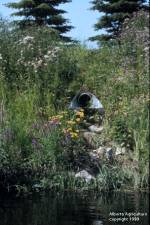
Purple loosestrife is found in wet areas and is often
found downstream of ornamental Lythrum plantings in urban centres.
Noxious Weed Status
Under Alberta's Weed Control Act, Purple Loosestrife is designated as a prohibited noxious weed. If found, it must be destroyed. It is the responsibility of the landowner to control the weed on his property. Weed inspectors will issue a weed notice to have the infestation controlled. Research indicates that cultivars of Lythrum can cross-pollinate amongst themselves or with Purple Loosestrife to produce viable seed, further contributing to the spread. Plants do not have to be near each other to cross-pollinate. Honeybees which can travel miles are common loosestrife pollinators. For this reason all domestic cultivars pose a threat as Purple Loosestrife. Most nurseries have voluntarily discontinued the sale of Lythrurn cultivars.
Eradication of Purple Loosestrife in Alberta
Infestation levels in Alberta are small and scattered compared to the other provinces. This makes eradication possible. Eradication involves eliminating seed production and monitoring for regeneration. To eliminate seed production, the flowering spikes can be clipped before flowers set seed in early August. The whole plant, including the roots, can be hand-dug with the aid of a shovel. Care must be taken to remove all the roots and stems. Removed plants should be sealed in a plastic bag for normal garbage disposal at a landfill site, or dried and burned where permitted. Purple loosestrife should not be composted, as the plant can regenerate from stems and roots.
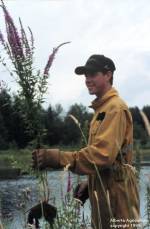
If you find purple loosestrife dig it out by the roots
and burn it (where permitted) or put it in a black
garbage bag and take it to the dump to be buried.
Environmental Impacts of Purple Loosestrife
- replaces native wetland communities
- eliminates food and shelter for wildlife species
- reduces biodiversity
- impacts fish spawning habitats
- reduces available waterfowl habitats
- threatens prairie pothole habitat where a large portion of North America's waterfowl breed
- impairs recreational uses of wetlands
- impedes water flow in drainage and irrigation ditches
Alternative Plants
If you have purple loosestrife in your garden, please remove it. Your local garden nursery can help you to select alternate perennials that pose no threat to the environment. Plants to consider are: Spiked Speedwell, Lilies, Siberian Iris, Spiked Gayfeather/Blazing Star, Garden Sage, Purple Coneflower.
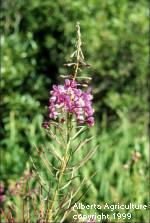
Common fireweed is of ten mistaken for Purple Loosestrife but has a roundstem and long seed pods at the base of the flower spike. | 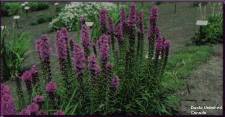
Liatris is a garden plant that is sometimes confused with Purple loosestrife however it has very dense flower clusters and thin string-like petals. |
Importance of Volunteers
Volunteers are very important to Alberta's eradication effort. With volunteers looking for and reporting Purple Loosestrife, and many hands helping in removal operations, we can eradicate this prohibited noxious weed from Alberta. We do need your help.
What Can You Do?
Report any Purple Loosestrife by contacting:
- Your local Weed Inspector;
- Dig out small infestations, remove entire plant including the roots.
- To prevent further seed spread, cut the see head/flower in July before it goes to seed,
- All plant parts should be sealed in a dark garbage bag and taken to a proper landfill or dried and burned where permitted.
- Do Not Compost!
- Use alternative perennials in your garden.
- Organize local clean-out campaigns and monitor site over several years.
Contributing Partners
Alberta Agriculture and Rural Development, Ducks Unlimited Canada, and Alberta Conservation Association.
Excerpts taken from Manitoba Purple Loosestrife Project Update, Spring 1993.
|
|